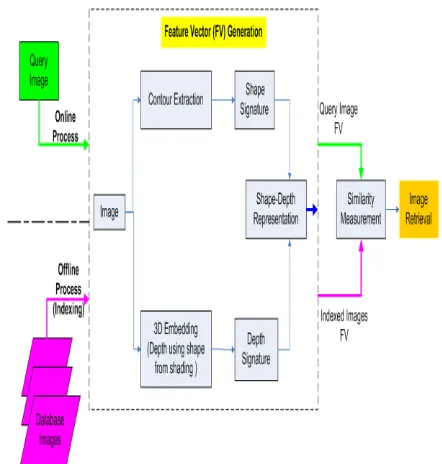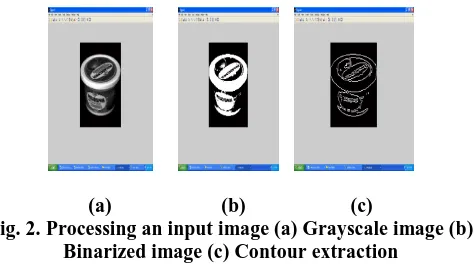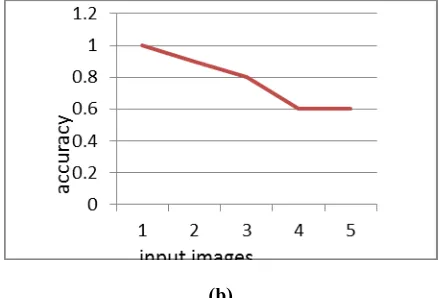Image Retrieval from an Engineering Database using
Shape and Depth Feature
Dayanand Jamkhandikar
1, Dr.V D Mytri
2, Reshma
31
Research Scholar CSE Dept. NIMS University, Jaipur 2
Principal Shetty Institute of Technology, Gulbarga 3
Computer science and Engineering, GNDEC, Bidar
Abstract- Content based image retrieval is a technique which uses visual contents like shape, color and texture to retrieve images from large scale image databases. In content based image retrieval shape is one of the primitive feature for image retrieval. Many images are classified and detected based on shape description. In this paper we present the methods for retrieving images from the large database which consist of engineering objects or models. The proposed work uses the shape information from an image along with 3D information. The 3D information can be obtained by obtaining depth map, for this a linear approximation procedure that can capture the depth information using the idea of shape from shading has been used. Retrieval of objects is done using a similarity measure that combines shape and the depth information.
Index Terms- CBIR, shape, Depth , contour.
I. INTRODUCTION
ontent-based image retrieval (CBIR) is used to describe the experiments into automatic retrieval of images from a database. This term has been widely used to describe the process of retrieving desired images from a large collection on the basis of features such as color, texture and shape that can be extracted automatically from the image itself The advantages to find a desired image from a large databases has wide applications, such as, in crime prevention by automatic face detection, finger print, medical diagnosis and so on. Visual contents to search images from large scale image databases has been an active research area for the last decade. Advances in the internet and digital imaging have resulted in an exponential increase in the volume of digital images.
The earliest use of different image retrieval technique were based on the manual textual annotation of images, which is intensively large and also often it depends on that persons imagination. Texts alone are not sufficient because of the fact that interpretation of what we see is hard to characterize by them. Hence, contents in an image, color, shape, and texture, started gaining prominence.
Even though different combinations of contents that is shape and color or shape and texture or color and texture and their possible descriptions have been tried, it is increasingly evident that a system cannot cater to the needs of a general database which consists of 3D engineering objects. Hence, it is more relevant to build image retrieval systems that are specialized to domains.
[image:1.612.333.554.389.621.2]In this paper, we propose an approach in which retrieving images from an engineering database which contains 3D objects has been presented. As the 3D objects are geometrically well-defined as compared to natural objects and also they rarely contain texture information, the appropriate feature to be used is shape. For every object the contour is captured which gives its two dimensional content along with its 3D embedding information, its depth profile at each pixel on the contour. Shape from an image is quite a powerful representation as it characterizes the geometry of the object. However, it is normally a planar profile, and is insufficient by itself to recognize objects that are typically 3D in nature. To take into account the third dimension, other parameters such as color and/or texture have been used. However, in our paper, we propose an approach that combines shape with the depth-map of the shape. The basic idea of our paper is illustrated in Fig. 1.
Fig. 1. Proposed method indicating the basic idea used in this paper
II. SYSTEMMODELANDRELATEDMETHODS
A. Shape extracting method
In the contour tracing algorithm shape contour can be obtained by using three steps as specified below the result of each of the step is given in fig.2.
1. Firstly convert the given image into gray scale image (Fig. 2(a)).
2. Then the converted gray scale image is binarized (Fig. 2(b)).
3. Contour from the binary image can be obtained by separating the object information from its background details. Applying the contour tracing algorithm generates the boundary shape (contours) of the object (Fig. 2(c)).
[image:2.612.52.289.169.301.2]
(a) (b) (c)
Fig. 2. Processing an input image (a) Grayscale image (b) Binarized image (c) Contour extraction
Shape signature, a one dimensional representation of the shape, is obtained by applying the 8-point connectivity technique on the 2D closed contour. As engineering/CAD objects have well defined centroid ( , and also retrieval has shown to be better with central distance [16], we use it as our shape representation. The feature vector representing the central distance between point on the contour (x, y) and the centroid ( , is given by:
=( x- , y- , 0) (1)
= , = and N is the total number of pixels.
B. Extraction of Depth Map from contour
Once the contour from the given shape (by using contour tracing algorithm) is obtained (as described in Section 2), its 3D information is then computed. The 3D information can be computed in terms of depth Z, the surface normal ), or surface gradient (p, q).
However, in this paper, we use only a single image as query and not a set of images. Hence, a principle of shape from shading has been used to obtain the 3D embedding information. Lambertian model [17], is a reasonable approximation for engineering objects, where Lambertian is assumed that equal amount of light is reflected in every direction. The parameters which are used in Lambertian reflectance are albedo, which is assumed to be constant and illuminant direction, which can be computed, in general.
To compute the depth-map of an image, we use the approach proposed by [17]. The linearity of the reflectance map in the depth Z has been used instead of in p and q. discrete approximations for p and q are employed and linearize the reflectance in Z(x, y). The reflectance function for the Lambertian surface is as follows:
E(x, y )=R(p, q) (2)
where E(x, y) is the gray level at pixel (x, y),
p = ,q = ,
is the tilt of the illuminant and σ is the slant of the illuminant. Discrete approximation of p and q are given by the following:
p = =Z(x, y) − Z(x − 1, y),
q = =Z(x, y)− Z(x, y − 1) (3) The reflectance equation can be then rewritten as: 0 = f (E(x, y), Z(x, y), Z(x−1,y), Z(x,y−1))
=E(x, y)−R(Z(x, y)−Z(x−1,y),Z(x, y)−Z(x,y−1)) (4)
For a fixed point (x, y) and a given image E, linear approximation (Taylor series expansion up through the first order terms) of the function f about a given depth map and solving using iterative Jacobi method results in the following reduced form:
0 = f (Z(x, y))
=f ( (5)
For , the depth map at n-th iteration can be solved using the following:
Where
Fig. 3. Depth map of the image
The depth map is then represented in a way similar to the shape (Equation (1)). The feature vector representing depth is given by:
(0, 0, Z − ) (7)
where Z is the depth obtained from Equation (6) of the contour, and denotes the third dimension of the centroid
III. REPRESENTATION,INDEXINGANDRETRIEVAL In this section, shape-depth representation is described, followed by Indexing using Fourier Descriptors and then a similarity measurement to describe the retrieval.
A. Representation of Shape-Depth
As we know that, shape alone is not sufficient to get a good retrieval. As we are dealing with well-defined geometric objects, our strategy is based on a 3D embedding has been adopted. Shape, in this paper, is combined with the corresponding estimated depth profile. Shape-Depth can be defined as. : → At each point on the contour, a vector is defined as follows:
V=( x − , y − , Z − (8)
This can be decomposed into (Equation (1)) representing the shape/contour and (Equation (7)) representing depth.
A weighted combination of the magnitude of the vectors and is used for retrieving images. Shape-Depth representation is defined as follows:
SD = (9)
where and are the weights assigned to the shape-based similarity and the depth-shape-based similarity, respectively and and .It can be observed that captures the central distance measure in the 2D domain and is a similar measure on the third dimension, the depth. hence it could prove to be a very useful one for retrieving objects/images.
B. Fourier Transform of Shape-Depth and Indexing
The important requirement of any representation for retrieval is that it is invariant to transformations such as translation, scaling and rotation. Fourier transform is widely used for achieving the invariance. For any 1-D signature function, its discrete Fourier transform is given by:
(10)
Where, n = 0, 1, . . . ,N − 1 and SD is given by Equation (9). The coefficients are usually called Fourier Descriptors (FD), denoted as . Since the shape and depth representations described in this paper are translation invariant, the corresponding FDs are also translation invariant. Rotation invariance is achieved by using only the magnitude information and ignoring the phase information. Scale normalization is achieved by dividing the magnitude values of the FDs with . The invariant feature vector used to index SD is then given by
f = , ,………., (11)
C. Similarity Measurement
In this paper as we are using only single image as query and not a set of images and retrieval result is not a single image but a list of images ranked by their similarities with the query image .Since CBIR is not based on exact matching. For a model shape which is query image’s shape indexed by FD feature
] and a database indexed by FD feature ] , the Euclidean distance between two feature vectors can then be used as the similarity measurement:
d= (12)
where N is the total number of sampled points on the shape contour
IV. EXPERIMENTALRESULTS
For testing the above approach, we have used a total of 1400 engineering database image. The database has multiple copies of an image and also it has same image in arbitrary position and rotation. The query image is also one of the image from the database. Test results for some objects are shown in Figs. 4(a) to 4(e), where only first six retrieved images are shown for the query image on the left.
In all the test results, it is to be noted that the query image is also retrieved, which indicates that the shape-depth representation is robust.
(a)
(b)
(c)
(d)
[image:4.612.71.265.99.722.2]
(e)
Fig. 4. Retrieval Results for some Engineering objects
[image:4.612.335.556.170.492.2]The important advantage in using the depth content of the image is that we can represent objects close to how it is in its three dimensional space. As we are using only a single image to compute the depth map, it will be close to its real depth only if the image is in its most informative position. However, in this approach, as we are not only dependent on the shape information (that is its contour) but also its depth, we can also retrieve objects that are in different orientation.
Table:1
Input image Matches 1 1 2 0.8 3 0.6 4 0.5 5 0.5 (a)
(b)
Fig 5(a),5(b) shows the values and corresponding graph for total number of images matched.
Table:2
[image:4.612.382.508.541.707.2](b)
Fig 6(a),6(b) shows the accuracy for the input images.
[image:5.612.57.279.58.207.2]The above graph is drawn by using the values from table2 ,for each query image how much accurately it matches with database image is shown.
Fig 7 the precession-recall graph of total matches and accuracy is drawn
By using the above figures we plot the precession-recall graph which shows that as number of matches increases the accuracy also increases.
V. CONCLUSION
The work carried out in this paper is very useful in retrieving the objects from an engineering database. The basic idea used is to combine the shape information which is extracted from the contour tracing algorithm. Depth information is extracted from this contour. The extracted feature vector are stored for all the database images. After applying the query image same features are extracted and given to the matching stage which uses the Euclidian distance between the two feature vectors and top matched six images are displayed. This approach may be used in other application domain such as meteorology, medicine, space exploration, manufacturing, entertainment, education, law
enforcement, defense, chemistry, forensics, mechanical CAD, paleontology, computer graphics and computer vision and protein search in molecular biology.
REFERENCES
[1] Huang, P., Jean, Y.: Using 2d c+-strings as spatial knowledge representation for image database systems 27, 1249–1257 (1994)
[2] Huang, J., Kumar, S.R., Mitra, M., Zhu, W.J., Zabih, R.: Spatial color indexing and applications. Int. J. Computer. Vision 35, 245–268 (1999) [3] Jain, A., Vailaya, A.: Image retrieval using color and shape. Pattern
Recognition 29, 1233–1244 (1996)
[4] Saykol, E., Gudukbay, U., Ulusoy, O.: A histogram-based approach for object-based query-by-shape-and-color in multimedia databases. Technical Report BU-CE-0201, Bilkent University, Computer Engineering Dept (2002)
[5] Caputo, B., Dorko, G.: How to combine color and shape information for 3d object recognition: kernels do the trick (2002)
[6] Diplaros, A., Gevers, T., Patras, I.: Combining color and shape information for illumination-viewpoint invariant object recognition 15, 1–11 (2006) [7] Pala, S.: Image retrieval by shape and texture. PATREC: Pattern
Recognition. Pergamon Press 32 (1999)
[8] Smith, J.R., Chang, S.F.: Automated image retrieval using color and texture. Technical Report 414-95-20, Columbia University, Department of Electrical Engineering and Center for Telecommunications Research (1995) [9] Li, X., Chen, S.C., Shyu, M.L., Furht, B.: Image retrieval by color, texture, and spatial information. In: Proceedings of the the 8th International Conference on Distributed Multimedia Systems (DMS 2002), San Francisco Bay, CA, USA, pp. 152–159 (2002)
[10] Carson, C., Thomas, M., Belongie, S., Hellerstein, J.M., Malik, J.: Blobworld: A system for region-based image indexing and retrieval. In: Third International Conference on Visual Information Systems, Springer, Heidelberg (1999)
[11] Shao, L., Brady, M.: Invariant salient regions based image retrieval under viewpoint and illumination variations. J. Vis. Comun. Image Represent. 17, 1256–1272 (2006)
[12] Veltkamp, R., Tanase, M.: Content-based image retrieval systems: A survey. Technical Report UU-CS-2000-34, Utrecht University, Department of Computer Science (2000)
[13] Datta, R., Li, J., Wang, J.Z.: Content-based image retrieval: approaches and trends of the new age. In: MIR 2005: Proceedings of the 7th ACM SIGMM international workshop on Multimedia information retrieval, pp. 253–262. ACM Press, New York (2005)
[14] Chang, H., Yeung, D.Y.: Kernel-based distance metric learning for content-based image retrieval. Image Vision Comput. 25, 695–703 (2007)
[15] Cz´uni, L., Csord´as, D.: Depth-based indexing and retrieval of photographic images. In: Garc´ıa, N., Salgado, L., Mart´ınez, J.M. (eds.) VLBV 2003. LNCS, vol. 2849, pp. 76–83. Springer, Heidelberg (2003) [16] Zhang, D.S., Lu, G.: A comparative study on shape retrieval using fourier
descriptors with different shape signatures. In: Proc. of International Conference on Intelligent Multimedia and Distance Education (ICIMADE 2001), Fargo, ND, USA, pp. 1–9 (2001)
[17] Tsai, P., Shah, M.: Shape from shading using linear-approximation. IVC 12, 487– 498 (1994)
[18] Lee, K.M., Kuo, C.C.J.: Shape from shading with a generalized reflectance map model. Comput. Vis. Image Underst. 67, 143–160 (1997)
[19] Jayanti, S., Kalyanaraman, Y., Iyer, N., Ramani, K.: Developing an engineering shape benchmark for cad models. Computer-Aided Design 38, 939–953 (2006)
AUTHORS
First Author –Dayanand Jamkhandikar, Research Scholar CSE
Second Author: Dr. V D Mytri, Principal Shetty Institite of Technology , Gulbarga, E-mail: vithalmytri@gmail.com
Third Author – Reshma, M.tech II year student in



